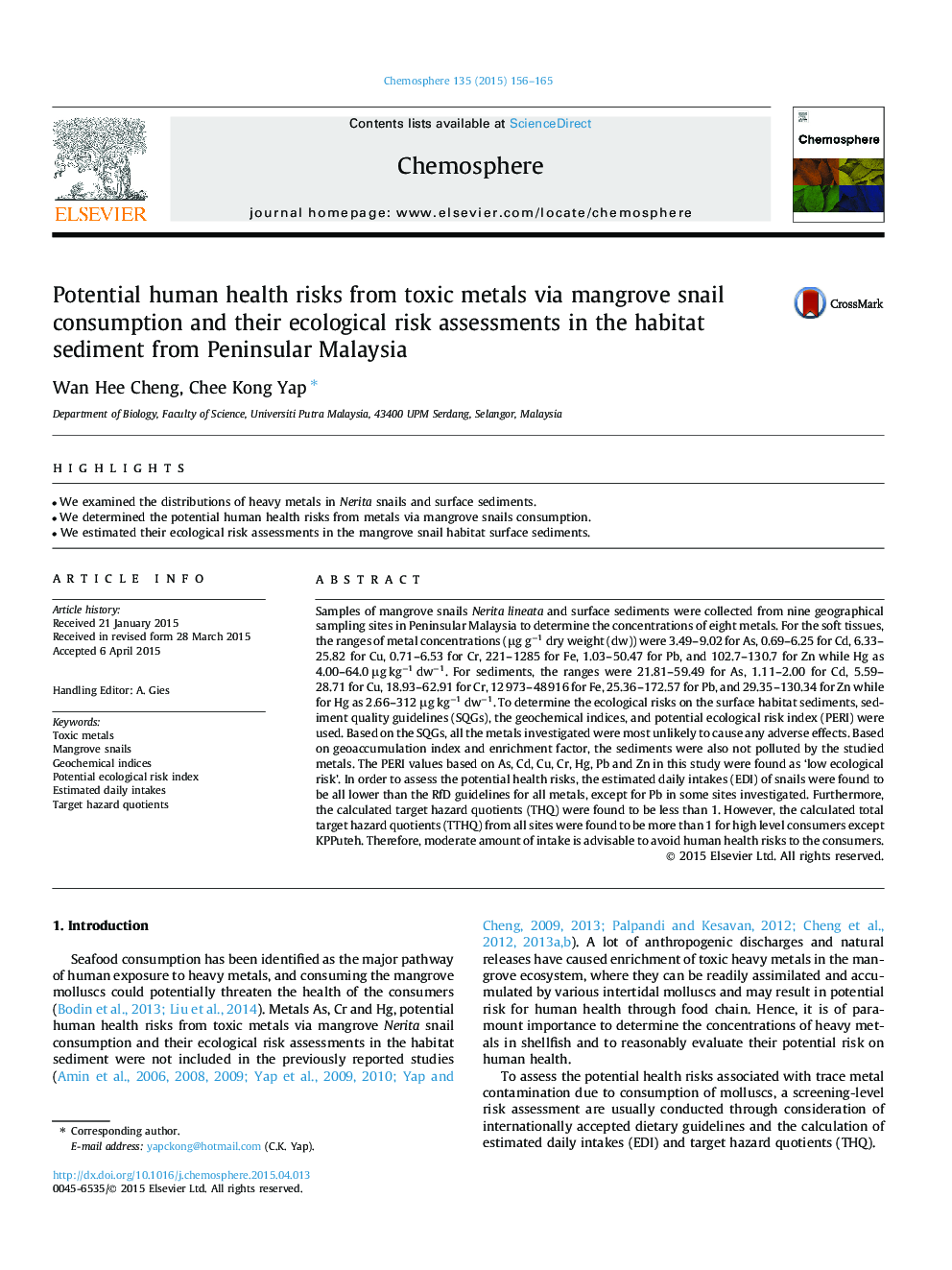| کد مقاله | کد نشریه | سال انتشار | مقاله انگلیسی | نسخه تمام متن |
|---|---|---|---|---|
| 6307823 | 1618836 | 2015 | 10 صفحه PDF | دانلود رایگان |
عنوان انگلیسی مقاله ISI
Potential human health risks from toxic metals via mangrove snail consumption and their ecological risk assessments in the habitat sediment from Peninsular Malaysia
ترجمه فارسی عنوان
سلامت بالقوه سلامت انسان از مواد سمی از طریق مصرف خوراک انبه و ارزیابی خطرهای زیست محیطی آن در رسوبات زیستگاه از مالزی شبه جزیره
دانلود مقاله + سفارش ترجمه
دانلود مقاله ISI انگلیسی
رایگان برای ایرانیان
کلمات کلیدی
فلزات سمی، حلزون انبه شاخص های ژئوشیمیایی، شاخص خطر زیست محیطی بالقوه، مصرف روزانه تخمینی، مقادیر خطر هدف،
موضوعات مرتبط
علوم زیستی و بیوفناوری
علوم محیط زیست
شیمی زیست محیطی
چکیده انگلیسی
Samples of mangrove snails Nerita lineata and surface sediments were collected from nine geographical sampling sites in Peninsular Malaysia to determine the concentrations of eight metals. For the soft tissues, the ranges of metal concentrations (μg gâ1 dry weight (dw)) were 3.49-9.02 for As, 0.69-6.25 for Cd, 6.33-25.82 for Cu, 0.71-6.53 for Cr, 221-1285 for Fe, 1.03-50.47 for Pb, and 102.7-130.7 for Zn while Hg as 4.00-64.0 μg kgâ1 dwâ1. For sediments, the ranges were 21.81-59.49 for As, 1.11-2.00 for Cd, 5.59-28.71 for Cu, 18.93-62.91 for Cr, 12 973-48 916 for Fe, 25.36-172.57 for Pb, and 29.35-130.34 for Zn while for Hg as 2.66-312 μg kgâ1 dwâ1. To determine the ecological risks on the surface habitat sediments, sediment quality guidelines (SQGs), the geochemical indices, and potential ecological risk index (PERI) were used. Based on the SQGs, all the metals investigated were most unlikely to cause any adverse effects. Based on geoaccumulation index and enrichment factor, the sediments were also not polluted by the studied metals. The PERI values based on As, Cd, Cu, Cr, Hg, Pb and Zn in this study were found as 'low ecological risk'. In order to assess the potential health risks, the estimated daily intakes (EDI) of snails were found to be all lower than the RfD guidelines for all metals, except for Pb in some sites investigated. Furthermore, the calculated target hazard quotients (THQ) were found to be less than 1. However, the calculated total target hazard quotients (TTHQ) from all sites were found to be more than 1 for high level consumers except KPPuteh. Therefore, moderate amount of intake is advisable to avoid human health risks to the consumers.
ناشر
Database: Elsevier - ScienceDirect (ساینس دایرکت)
Journal: Chemosphere - Volume 135, September 2015, Pages 156-165
Journal: Chemosphere - Volume 135, September 2015, Pages 156-165
نویسندگان
Wan Hee Cheng, Chee Kong Yap,
